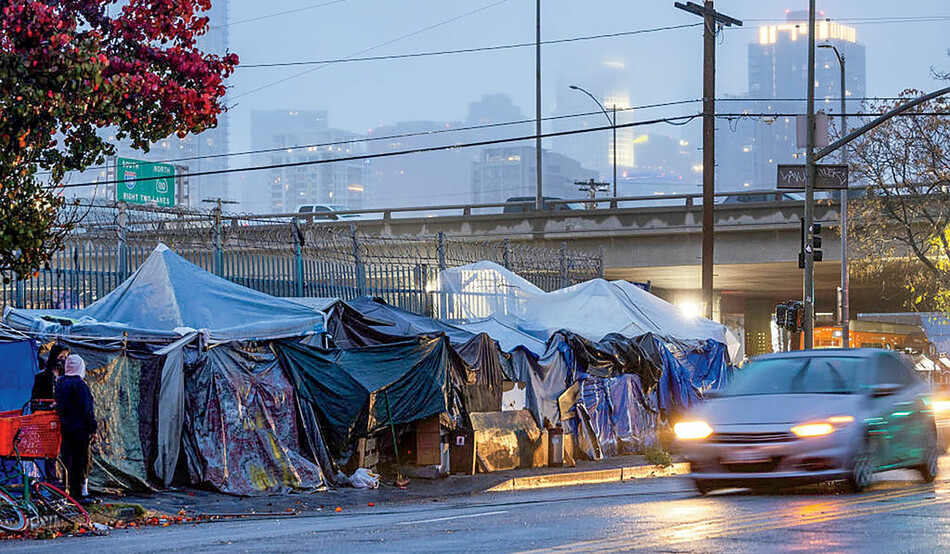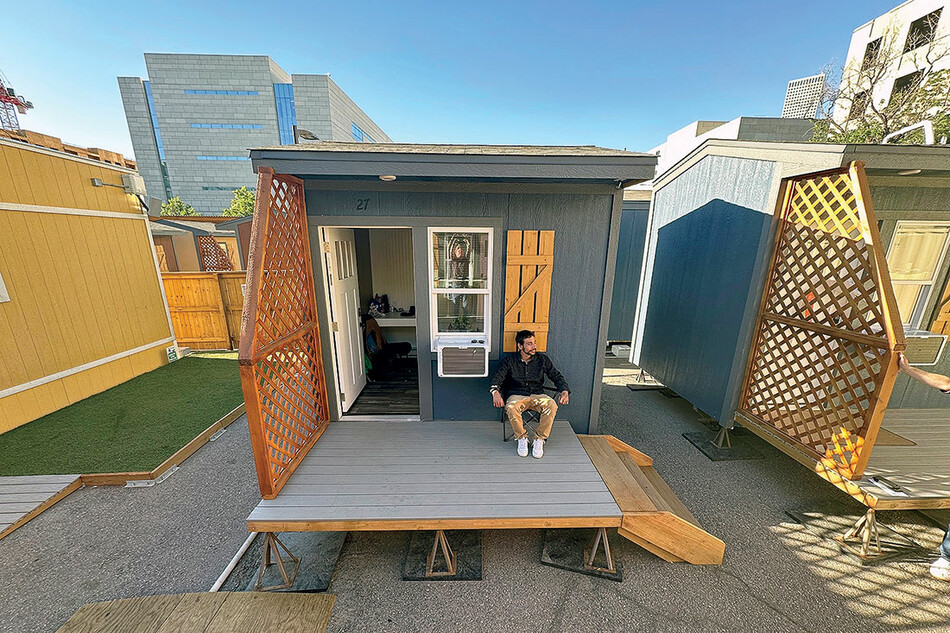On a misty morning this past June, Denver mayor Mike Johnston stood before a small crowd in his city’s bustling downtown business district and made a surprise announcement. Despite Denver’s mounting homelessness crisis — on any given night some 1,300 people could be found sleeping in boxes, tents, and vehicles —the city was on the cusp of solving the issue for one key group: military veterans. Nearly one hundred veterans a night had been sleeping on the streets a year earlier, but by the start of summer that number was down to fifty-two. Johnston pledged that by year’s end, none would be without a place to stay.
“We will announce today a plan to make Denver the largest American city ever to reach ‘functional zero’ for veterans’ homelessness,” Johnston said, evoking a term favored by policy wonks to describe a city’s ability to move people into new housing as swiftly as they appear on the street. He said the strategy would be driven by aggressive street outreach, the construction of tiny homes on public land, and the provision of health care, substance-abuse counseling, and job-training services for people seeking shelter. Veterans would be the initial focus, out of respect for their sacrifices, Johnston emphasized, but the effort would soon be expanded to other homeless Denverites. “This is just the first step,” he said.
Local residents, having grown weary of the sight of tent encampments and concerned about threats to public safety — including open drug use, unattended fires, and occasional confrontations between campers and passersby — responded to the news with a mixture of relief and incredulity. On social media many wondered aloud: Do these people even want homes? Shouldn’t they get their lives in order first? How can the city possibly afford to house them all?
Yet Johnston’s plan, for all its ambition, was firmly grounded in the latest social-science research. Experts listening to his press conference might have thought they had stumbled upon a graduate lecture in how to shelter people humanely and cost-effectively. They also would have detected, in the details of his plan, the unmistakable influence of Rosanne Haggerty ’89GSAPP, the founding president and chief executive officer of the New York–based nonprofit Community Solutions. A national leader in the fight against homelessness, Haggerty is known for crafting ambitious, data-driven initiatives that have dramatically reduced homelessness in dozens of US cities. One of her signature strategies is implementing sophisticated analytic systems that enable officials to monitor the size of their homeless populations in real time and respond in kind. Another is helping cities break down bureaucratic barriers that impede their progress. Yet another is finding novel ways to finance affordable-housing projects. In Denver, Haggerty’s organization has been working on all of these fronts for years.
“Denver is an interesting case, because they have a significant issue with homelessness, and yet the city’s leaders, rather than merely attempting to manage the situation with stopgap measures, are actually trying to solve it,” says Haggerty, a sixty-four-year-old with sharp blue eyes and a calm, easygoing confidence. “That’s unusual for a large city — and extremely exciting.”
“The vast majority of people experiencing homelessness … desperately want homes. The problem is that the systems that are supposed to be helping them are failing.”
“Solve” is a word that comes up frequently when speaking with Haggerty. She’s been trying to insert it into the national conversation on homelessness since the 1990s, when, fresh on the heels of earning a master’s degree in real-estate development from Columbia’s Graduate School of Architecture, Planning, and Preservation, she founded her first nonprofit and began converting rundown New York City buildings into sleek new residences for people living on the streets. It wasn’t easy then, and it’s not easy now, she says, to persuade anyone that ending homelessness is an attainable goal.
“We tend to view homelessness as this overwhelmingly complex, intractable social problem that we just have to deal with,” says Haggerty, a past recipient of a MacArthur Foundation “genius” grant. “But that’s not true. And the notion that combating homelessness is futile is a big part of the challenge we’re confronting now.”
Here’s another challenge: counteracting the myth that homeless people have opted out of society and are either uninterested in or incapable of living in a home. “The vast majority of people experiencing homelessness, including those who’ve been on the streets for long periods of time, desperately want homes,” says Haggerty. “The problem is that the systems that are supposed to be helping them are failing.”
The scale of homelessness in the US today is staggering. There are currently 650,000 Americans experiencing homelessness — a number that has increased sharply over the past decade — and on average people are staying homeless for longer. The problem is endemic to nearly every US city, as well as to many suburbs. The main drivers of the crisis are clear enough: government investments in affordable housing have fallen short, and elected officials in many suburban areas, from Westchester to Santa Monica, have enacted zoning regulations that make it more difficult to construct apartment complexes or multifamily dwellings. This is squeezing the rental market in and around cities, creating unprecedented housing insecurity for low-income people. One recent study found that nearly a quarter of all US renters spend more than half their income on rent and utilities.
It is worth noting that most people experiencing homelessness are going through a temporary rough patch and will find a new place to live within a few months, often with the help of rental subsidies. But about one-quarter are chronically homeless as defined by the federal government, meaning they have been on the streets for over a year and are affected by a disabling condition like a mental illness or substance-use disorder. The chronically homeless tend to be older, male, and from disadvantaged backgrounds; people of color, military veterans, and survivors of childhood abuse and trauma are disproportionately represented among them. Helping these individuals regain stable housing can be difficult and expensive. Many will require heavily subsidized housing, along with on-site social support, for the rest of their lives. But one of Haggerty’s greatest achievements has been to help demonstrate that cities can rehouse large numbers of chronically homeless people without breaking their budgets. “Cost studies have shown time and time again that communities can actually save money on balance by addressing chronic homelessness rather than ignoring it,” she says. “Cities are already spending enormous amounts of money not solving the problem, in part because people on the street require lots of emergency medical care and often get ensnared in the criminal-justice system. The costs are spread all over the place, so we don’t notice them.”
There are currently 650,000 Americans experiencing homelessness — a number that has increased sharply over the past decade.
Haggerty and her colleagues at Community Solutions are working with officials in Denver and many other cities to help them redesign their housing systems and social services. Yet Haggerty’s vision extends far beyond these committed allies. She hopes that success in places like Denver will inspire a transformative national approach by showing other cities that homelessness can be reduced with smart, compassionate solutions grounded in data analytics. Too often, she observes, municipal agencies fall into fatalism and complacency, overwhelmed by the scale of the problem and misled by outdated perceptions that homeless people are beyond help. “The tone is often set by the chief executive,” Haggerty says. “If your mayor thinks that homelessness is unsolvable, he or she may try to hide the problem by harassing people out of town with police sweeps or sticking everyone in shelters rather than actually housing them. And that sense of resignation can then flow down the command chain.”
To date, Haggerty has developed more than five thousand affordable-housing units through Community Solutions and her first nonprofit, Common Ground. She has also guided local governments in rehousing more than one hundred thousand people experiencing chronic homelessness. But her organization’s latest initiative, Built for Zero, is its most ambitious yet, helping 140 US cities work toward ending homelessness altogether. So far, nineteen of these cities have ended homelessness among certain subgroups of their unhoused populations, like the chronically homeless or veterans. While many of these successes have come in small cities — places like Hackensack, New Jersey; Chattanooga, Tennessee; Bakersfield, California; and Rockford, Illinois — Haggerty’s ambitions extend to larger, more challenging urban areas.
“There’s no reason why our approach can’t be scaled up to New York, LA, Chicago, or any other big metropolis,” Haggerty says. But to prove it, she and her colleagues are first going to demonstrate that their strategy works in places like Denver, San Diego, Nashville, and Sacramento.
The term “homelessness” was first used in the United States in the 1870s to describe people who traveled the country looking for work. A century later, a more insidious and pervasive iteration emerged. In 1970s New York City, throngs of men and women began appearing slumped in doorways, panhandling on subways, and curled up on steam vents — scenes of mass destitution that had rarely been witnessed in America since the Great Depression. Widely perceived as a stark symbol of Gotham’s moral decay, the sprawled-out bodies obstructing sidewalks elicited panicked pleas for “cleanups” and arrests. The police regularly obliged.
Public attitudes toward the city’s homeless population began to soften only slightly with the 1981 publication of Private Lives / Public Spaces, a landmark work of guerrilla ethnography by then Columbia graduate students Ellen Baxter ’81PH and Kim Hopper ’75GSAS, ’87PH. Baxter and Hopper spent almost two years huddled up alongside dozens of homeless people in New York City shelters, parks, and bus depots, and the resulting interviews gave readers their first intimate glimpse into the lives of the dispossessed. Baxter and Hopper’s research revealed that large numbers of street dwellers were former psychiatric patients who had been released into the community after the state, in a frenzy of budget cutting, shuttered several local mental hospitals. Many others had previously lived in flophouses, tenement hotels, and single-room-occupancy buildings that had been torn down to make way for luxury hotels, condominiums, and office towers. Some had jobs — as dishwashers, housekeepers, messengers, and factory workers — but could no longer manage to afford an apartment in the rapidly gentrifying city. Of course, there were idlers, drunks, addicts, and swindlers among them. In a city where thousands of people wound up on the street, any number of paths might lead there. But only systematic economic and policy failures, Baxter and Hopper suggested, were likely to explain the new trend.
The release of Private Lives / Public Spaces inspired scores of journalists, activists, and progressive politicians to push for more humane treatment of the homeless. It also helped give rise to the modern interdisciplinary field of homelessness studies, which for the next two decades was anchored at Columbia University. In the 1980s, Columbia urban-planning scholar Peter Marcuse ’62GSAS revealed how segregation, gentrification, and underinvestment in low-income neighborhoods contributed to homelessness. Columbia economist Brendan O’Flaherty then did seminal work linking affordable-housing shortages, rent increases, and wage stagnation to rising homelessness rates. Their urban-planning colleague Elliott D. Sclar gave the field one of its most enduring metaphors, likening a tight rental market to a game of musical chairs at a child’s birthday party. Hopper, who went on to become a Columbia law and public-health professor, continued to study the daily lives of homeless people, including the extraordinary bureaucratic hurdles they face when trying to access public services, like housing assistance or legal aid.
Haggerty, who grew up in West Hartford, Connecticut, arrived in New York City fresh out of Amherst College in 1982. Captivated by the reform spirit then percolating in Greenwich Village cafés and bookstores, the earnest twenty-one-year-old took a job counseling runaway youths at a shelter in Midtown and in her free time volunteered at a shelter for homeless women. The experience would profoundly affect her, setting the course for her career. “I think because homelessness was still relatively new, I figured that we could nip it in the bud,” she says. “There were far fewer people living on the streets back then compared to today. My attitude was, ‘Come on, everybody, we can do this! Let’s find these people new homes!’”
After a few months, though, Haggerty grew disillusioned — not because the shelters’ clients seemed beyond reach but because the chaos of their lives was met by an equally disorganized, and blindly indifferent, system the city had built to assist them. “I’d come in expecting a master plan,” she remembers, “but there wasn’t one. Many of the people I met had absolutely no idea how they’d ever leave the streets, and we didn’t either. After a while, nobody even talked about it.”
Determined to make a deeper impact, Haggerty soon accepted a position with Catholic Charities of Brooklyn and Queens, working on efforts to convert underused church properties into housing for the formerly homeless. She spent the next several years learning to navigate the byzantine world of affordable-housing development, cobbling together complex funding packages while balancing the competing interests of city agencies, nonprofits, and neighborhood groups wary of welcoming low-income housing into their backyards. She eventually led the transformation of three vacant schools and an orphanage into housing for 225 people.
“This work suited me,” Haggerty says. “It is satisfying to create housing, because you’re offering a tangible solution. I wanted to learn to do it at a larger scale, to serve more people.”
That led her to enroll in Columbia’s real-estate-development program, which has long emphasized socially responsible housing practices. There she honed her skills in market analysis, financial modeling, public–private partnerships, and property management. She learned from architectural historian Gwendolyn Wright the history of housing-reform movements and how residential design can foster feelings of stability, dignity, and connectedness when executed well and isolation and hopelessness when executed poorly. She drew insights from real-estate-finance expert Charles S. Laven not only on securing funds but on continuing to persevere in the face of bureaucratic obstacles. “Chuck showed me that no matter how frustrating the development process can be, you can always approach the work with a sense of fun, curiosity, and delight,” she says.
The year after she graduated, Haggerty got her first breakthrough opportunity. New York City was poised to condemn the Times Square Hotel — an infamously dilapidated, crime-ridden Beaux Arts building with fifteen stories and seven hundred units — and was entertaining redevelopment proposals. While most developers envisioned upscale apartments, Haggerty had a different plan: “I proposed a full renovation with new efficiency units, but for tenants we’d bring in some of the most vulnerable of the city’s homeless, including those with serious mental-health issues,” she recalls. To make this vision a reality, she founded her first nonprofit, Common Ground, and offered herself up as the building’s next landlord. Columbia’s Center for Urban Community Services, created in 1979 to fight homelessness in New York City, joined her proposal, agreeing to provide tenants a full range of on-site social services. (The center branched off from Columbia and became an independent organization in 1993.) “We proposed a model where tenants would sign leases and pay 30 percent of their income if they worked, supplemented by a patchwork of grants, subsidies, and tax credits we stitched together,” Haggerty says. “Tenants would be expected to follow building rules and generally be good neighbors, with a team of social workers on hand to resolve any conflicts.”
This novel housing concept — the first component of Haggerty’s own master plan — was directly inspired by Baxter, who had already demonstrated its potential by opening a handful of smaller residential facilities for chronically homeless people in Upper Manhattan. Haggerty believed that Baxter’s approach, which came to be known as permanent supportive housing, could be turned into a far-reaching solution. “Ellen’s work was the turning point, demonstrating what was possible when people are given the right support,” Haggerty says. “I wanted to figure out a way to make the model replicable in any neighborhood or city.” Among Haggerty’s innovations was the idea to set aside some apartments for tenants who would pay market rent. “I thought that in addition to making the finances work, this would help establish a stable living environment,” she says.
Against all odds, Haggerty’s Times Square Hotel project was approved by the city and became a resounding success, with hundreds of formerly homeless people dutifully paying their rent, taking yoga and cooking classes together, and rebuilding their lives. The vast majority of them would remain stably housed in the ensuing years, with many reintegrating into the workforce. (Dozens of tenants worked on the premises, stocking soda machines, providing security, and scooping ice cream in a ground-floor Ben & Jerry’s.) Haggerty’s triumph made national headlines, offering a bold new vision for what homelessness services could be.
Over the next decade, Haggerty helped spearhead the development of similar sites in Toronto, London, and Tokyo, as well as in other US cities, establishing herself as the nation’s leading provider of permanent supportive housing. Her team used a constantly evolving model of social support that built upon Baxter’s original approach. For example, Haggerty and her colleagues at Common Ground were early adopters of a pioneering philosophy developed by psychologist Sam Tsemberis, a member of the Columbia faculty from 2007 to 2018, who advocated providing permanent housing to chronically homeless people without first requiring them to accept treatment for psychiatric or substance-abuse issues. This “Housing First” model cut against clinical orthodoxy, but Haggerty’s team provided some of the first large-scale, sustained evidence in support of the idea. “We found that people are likelier to stick with treatment if they have a stable home first,” says Haggerty, “which makes sense — how are you going to engage in serious self-care while living on the street or in a shelter?”
By the early 2000s, though, Haggerty was growing restless. She was creating affordable housing across the country, rehabbing buildings and helping community leaders develop their own supportive housing projects, yet homelessness was still on the rise. This seemed to confirm for her a troubling suspicion that the crisis wasn’t only about a housing shortage; it stemmed from deeper, more elusive forces. Signs of structural breakdown were all around her — cities pouring millions into sprawling shelter systems that failed to provide pathways to permanent housing, sidewalks still crowded with homeless people in neighborhoods where her latest residences had just opened. In city after city, she observed overstretched outreach teams, agencies with muddled missions that didn’t align, and an overall lack of urgency in helping those who needed it most. “I’d often hear about housing vouchers going unused,” Haggerty says, “and affordable-housing units sitting vacant because of endless bureaucratic delays.” Haggerty decided that without a fundamental rethinking of how municipal governments approached homelessness, her efforts would ultimately fall short. “A lack of housing was clearly driving the crisis, but new housing alone wasn’t enough, because there was also a systemic failure to respond effectively,” she says.
To better understand the problem, Haggerty and her colleagues began to investigate how homelessness response systems functioned in their own backyard, on the streets surrounding the Times Square Hotel. Through interviews with scores of local service providers and homeless people, they uncovered serious flaws. Chief among them was the discovery that New York City’s response system had evolved into an unwieldy hodgepodge of public and private programs that operated in silos, with little incentive to collectively move people into permanent housing. “Organizations with government contracts were often evaluated on narrow metrics, like how many people they temporarily sheltered or counseled,” says Haggerty. “There was little consideration of whether their efforts ultimately got people housed.” Homeless people, meanwhile, expressed frustration that outreach workers frequently gave them rides to shelters, soup kitchens, or counseling centers — but rarely offered them concrete help in finding homes. “Providers were offering what they were accustomed to giving rather than listening to what people actually wanted,” Haggerty recalls. “This led to many people on the streets being wrongly labeled as ‘service-resistant’ — code for saying someone is incapable of being helped — when that often wasn’t true.”
In 2003, Haggerty persuaded a number of New York City agencies and nonprofits to join Common Ground in an ambitious experiment to try to solve, rather than merely manage, homelessness in and around Times Square. The coalition began by mapping homelessness in a one-square-mile area, sending waves of outreach workers into the streets to get to know every homeless person by name, to build trust, and to document their histories, vulnerabilities, and needs. The organizations then worked collaboratively to guide the most vulnerable individuals — those who had lived on the streets the longest and were the least able to advocate for themselves — through the complex process of securing housing. This meant helping them obtain identification, complete psychiatric evaluations, apply for housing assistance, and prepare for landlord interviews. Sharing information between agencies proved pivotal. “Someone might qualify for a housing subsidy that only one organization knew about or have critical documents on file somewhere that no one else was aware of,” Haggerty says. The team also enlisted hospital staff, police officers, and parks workers. “If someone was treated at an emergency room for a serious illness, we wanted to make sure they were subsequently referred for housing assistance rather than being discharged back onto the street,” she explains.
The results of Haggerty’s initiative, called Street to Home, were remarkable. Between 2003 and 2008, the program nearly eradicated homelessness in its target area and contributed to a 43 percent reduction in surrounding West Midtown neighborhoods. Haggerty’s team was then invited by Los Angeles officials to help them design a similar pilot program on Skid Row, which successfully housed dozens of chronically homeless people. Soon, communities across the country were seeking Haggerty’s guidance in replicating the strategy.
Over time, a new vision emerged. “We found that cities make the most progress when they respond to homelessness as if it’s a public-health emergency,” Haggerty says. “City leaders should convene regular meetings with representatives from every agency, nonprofit, and community group that has information about the homeless population and require real-time data sharing. They should demand to know exactly how many people are on the street and how many have been placed into permanent homes. Clear goals should be established, and programs held accountable.” For example, shelters shouldn’t be rewarded simply for filling cots, soup kitchens for serving meals, or sobriety programs for issuing certificates. “Instead,” says Haggerty, “everyone should be measured by one metric: how effectively they contribute to getting people housed and reducing homelessness. Period.”
In 2011, Haggerty and several colleagues left Common Ground to establish Community Solutions, a nonprofit focused on improving the nation’s homelessness response systems. Common Ground soon rebranded as Breaking Ground and narrowed its mission to concentrate on developing and managing supportive housing in New York and Connecticut. Today, Breaking Ground continues to operate the Times Square Hotel, which remains the largest supportive-housing residence in the country.
On a Friday morning in late November, Jamie Rife, the executive director of Denver’s Department of Housing Stability, opened a laptop on her desk and reviewed data on the city’s homeless veterans. As she scrolled, Rife zeroed in on the details for the nine veterans still out on the street, examining their progress: who had been issued a housing voucher, who had a landlord lined up, and who was just days away from move-in.
Rife, who is Mayor Johnston’s top deputy in the city’s fight against homelessness, leads a command center comprising ten agencies and organizations. It meets twice daily — once at 9 a.m. and again at 5 p.m. “Every morning we see updates on what each veteran needs next and we decide who among us can deliver that,” she says. “Then we all go away with our list of to-dos for the day.”
Rife credits much of Denver’s recent success in housing veterans to technological guidance from Community Solutions. Using a specialized data dashboard originally created by a Seattle firm to help health officials monitor disease outbreaks, Denver city agencies and nonprofits can track their efforts in real time, analyzing information on veterans’ movements in and out of homelessness and coordinating responses seamlessly. The city has also embraced procedural innovations recommended by Haggerty’s organization, like iterative learning, in which outreach teams are constantly assessing the effectiveness of their strategies, refining their methods as they go.
“You can’t solve a problem that you don’t understand,” says Rife. “And for a long time, we didn’t understand homelessness in Denver, either in the aggregate or at the level of individuals.”
Denver is not alone in making progress on housing homeless veterans. Cities across the US have been bringing veterans off the street, supported by a major federal initiative. Since 2008, Congress has issued 110,000 housing vouchers for veterans through HUD-VASH, a joint program of the Department of Housing and Urban Development and the Department of Veterans Affairs. This effort has halved the number of homeless veterans, even as overall homelessness has risen. Yet challenges remain, since many cities struggle to identify all veterans who qualify for the program and to place them in appropriate homes. There remains a nationwide shortage of supportive-housing units, and voucher holders looking for apartments on the open market often say landlords are unwilling to rent to them. Consequently, a quarter of all HUD-VASH vouchers go unused, and some thirty-five thousand veterans remain homeless.
“Once communities succeed in housing veterans, they often find it fosters a deeper sense of compassion for helping others experiencing homelessness.”
Haggerty and her colleagues are working with cities to help them fully capitalize on these vital resources. They hope that as communities refine their methods and eliminate homelessness among veterans, they will build the political momentum and secure the funding necessary to end homelessness among other vulnerable groups. Some cities now partnering with Community Solutions on its Built for Zero campaign have already achieved such milestones. Abilene, Texas, a city of 125,000 in the western part of the state, has effectively eradicated both veterans’ and chronic homelessness by expanding its outreach efforts — even conducting regular searches of nearby forests to find and assist people living outdoors. Bergen County, New Jersey, whose county seat is Hackensack, has accomplished the same by creating a countywide trust fund to subsidize rents for formerly homeless people and establishing a one-stop service hub where people can access housing-placement and support programs.
“One of the benefits of prioritizing veterans is their cause garners broad bipartisan support,” says Haggerty. “Once communities succeed in housing veterans, they often find it fosters a deeper sense of compassion for helping others experiencing homelessness.”
Could a major metropolitan area like Denver achieve similar results? This would be extremely challenging, since the sheer scale of homelessness in large cities stretches resources to their limits. Federal funding falls far short of addressing the needs of everybody experiencing chronic homelessness. For example, while the HUD-VASH program provides nearly one housing voucher for every homeless veteran nationwide, the availability of federal rental assistance for homeless non-veterans is much scarcer, reaching only a small fraction of those in need. Denver, like many large US cities, has attempted to bridge the gap through investments in rental assistance and affordable housing, committing $242 million in 2024. Yet homelessness in the city continues to rise — it was up 10 percent from 2023 to 2024. Experts attribute this to decades of underinvestment in affordable housing, the rising cost of living, and an influx of wealthy professionals drawn to Denver’s growing tech and finance sectors — a trend that has driven up rents and displaced lower-income residents.
This is a pattern playing out in many US cities. And while elected officials across the country are working to loosen zoning restrictions and accelerate construction, the slow pace of affordable-housing development poses a hurdle. These projects often take years to get financed and approved, so rental markets will likely remain tight for the foreseeable future, economists say.
Yet in Denver, housing advocates have reason for hope. Over the past year, the Johnston administration, working closely with Community Solutions, has demonstrated increasing ingenuity in addressing the homelessness crisis. It has launched pilot “micro-communities” — clusters of tiny homes paired with wraparound social services — and has announced plans to repurpose vacant office buildings into affordable housing. Additionally, Community Solutions has helped to transform several old buildings in Denver into supportive housing, employing an innovative financing model conceived by Haggerty’s team and a Philadelphia-based investment firm: socially conscious investors pool resources into a private-equity fund that acquires and renovates properties, which are then managed by nonprofits that lease units to homeless individuals and families. “Now you have landlords who truly understand the needs of these tenants,” explains Haggerty, emphasizing that property conversions offer a much quicker path to expanding housing supply compared to ground-up construction.
Denver has also shown a willingness to take on entrenched interests that critics say have slowed progress in the past. The city is now sending proportionally fewer homeless people into temporary emergency shelters, some of which The Denver Gazette, in a recent investigative series, found had insufficiently supported people in their efforts to find new homes.
Meanwhile, Rife is exploring how advanced data analytics could prevent homelessness in the first place. “We now have a much clearer picture of the life circumstances that lead people to lose their homes,” she says. “Young people leaving foster care are particularly vulnerable, as are older adults who lose a spouse. I’m hoping that we can use this data to proactively identify and assist people in these situations, providing rental support before they end up on the street.”
Haggerty, whose optimism is unshakable, is certain this is possible. “We have the tools to keep people in their homes and to make sure that homelessness is rare and brief when it does occur,” she says. “What’s needed is the collective will to use them.”
This article appears in the Winter 2024-25 print edition of Columbia Magazine with the title "Off the Streets."





